Turning your outdoor space into something amazing can seem hard, especially with a steep slope. But, with the right plan, you can make this tough area beautiful and useful.
Landscaping a steep hill needs careful thought and creativity. The right techniques and design can make your outdoor space stunning. It will not only make your home look better but also be a safe place for fun and relaxation.
With the right help, a hard slope can become a stunning landscape feature. In this article, we’ll look at the important things and strategies for successful steep hill landscaping.
Key Takeaways
- Understand the challenges and opportunities of steep hill landscaping
- Learn how to choose the right plants for slope stabilization
- Discover design elements that enhance your outdoor space
- Explore strategies for safe and accessible slope landscaping
- Find out how to maintain your steep hill landscape
The Unique Challenges and Opportunities of Hillside Properties
Hillside properties are a complex canvas for landscaping. They come with both obstacles and opportunities. The sloping terrain can be a challenge but also a unique selling point. It offers breathtaking views and the chance for creative landscaping designs.
Common Problems Homeowners Face with Sloped Terrain
Homeowners with sloped terrain face several issues. These include soil erosion, trouble accessing different parts of the property, and keeping the landscape stable and appealing. Heavy rainfall can make erosion worse, and specialized maintenance equipment is often needed.
- Soil erosion due to water runoff
- Difficulty in planting and maintaining vegetation
- Accessibility issues for maintenance and recreation
The Hidden Potential of Well-Designed Hillside Landscapes
A well-designed hillside landscape can overcome the challenges of sloped terrain. It can unlock its potential. By using strategic planting, terracing, and other techniques, homeowners can create a stunning outdoor space.
Such designs can make the property more beautiful, increase its value, and add functional areas for fun or relaxation.
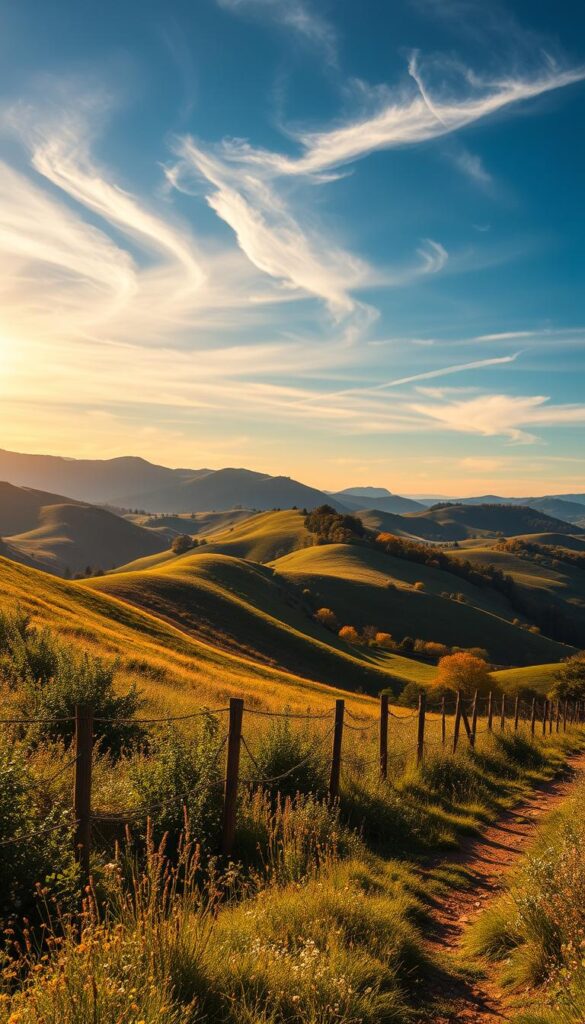
Effective hillside landscaping can turn a liability into a significant asset. It enhances both the beauty and functionality of the property.
Essential Planning Steps for Successful Steep Hill Landscaping
To landscape a steep hill well, you must first assess your slope. Then, plan for drainage and set a budget. This approach makes your project look good and work well.
Assessing Your Slope’s Grade and Soil Composition
Knowing your slope’s grade is key to choosing the right landscaping. You can use a clinometer or get help from a pro. Also, check your soil to pick the best plants and materials.
Soil testing shows its pH level and nutrients. This helps pick plants and what amendments you need.
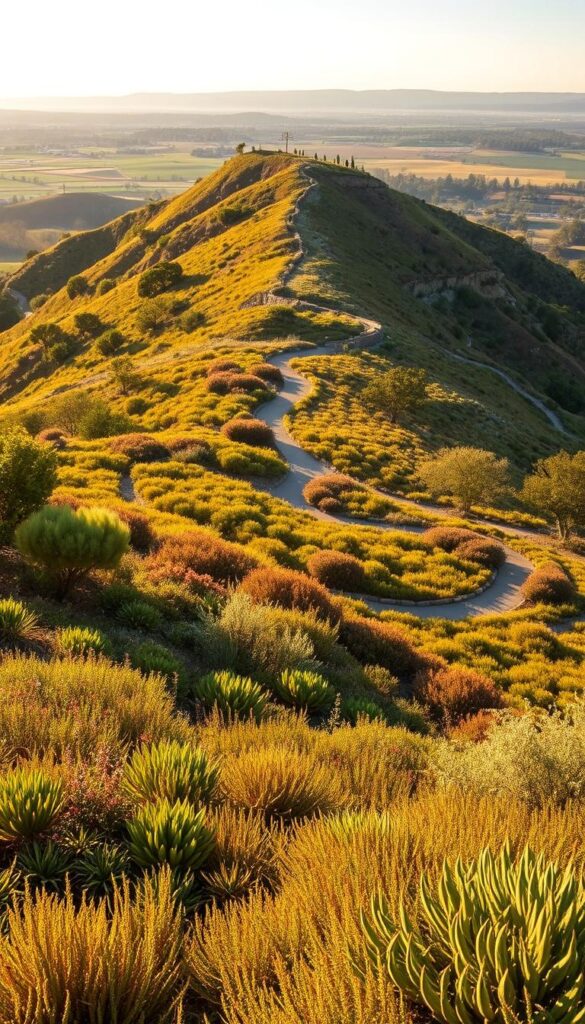
Creating an Effective Drainage Strategy
A good drainage system stops erosion on steep hills. Use French drains or swales to move water. Good drainage keeps your landscape safe and adds beauty with water features.
Setting a Realistic Budget and Timeline for Hillside Projects
Having a realistic budget and timeline is crucial. Think about material, labor, and extra costs. Breaking your project into parts helps manage money and stress.
A clear timeline keeps you moving forward. It helps you reach your landscaping goals.
Erosion Control Techniques for Steep Hillsides
Steep hillsides need strong erosion control to stop soil loss and keep landscapes looking good. Good erosion control keeps your landscape safe and beautiful.
Plant-Based Solutions to Prevent Soil Runoff
Plant-based solutions are a top choice for stopping erosion on steep hillsides. Deep-rooted plants hold the soil in place, stopping runoff and landslides. Native plants are great because they fit well with the local environment, need little care, and help local wildlife.

Structural Methods to Stabilize Sloping Ground
Structural methods are also key for keeping sloping ground stable. Retaining walls give the soil a strong back, stopping erosion. Other methods like geotextiles and gabions also help, by making the soil stronger and controlling water.
Integrated Approaches for Long-Term Erosion Prevention
For lasting erosion prevention, mixing plant-based solutions with structural methods works best. This approach tackles erosion right away and makes the landscape stronger over time. By using different methods, you can make your hillside both beautiful and sustainable.
| Erosion Control Method | Description | Benefits |
|---|---|---|
| Plant-Based Solutions | Using deep-rooted plants to stabilize soil | Eco-friendly, supports biodiversity, low maintenance |
| Structural Methods | Retaining walls, geotextiles, gabions | Immediate soil support, manages water runoff |
| Integrated Approaches | Combining plant-based and structural methods | Long-term erosion prevention, enhanced landscape resilience |
Terracing: Creating Functional Spaces on Your Steep Hill
Terracing turns a steep hill into beautiful outdoor areas. It makes your land more useful and looks great. Level areas on a slope add beauty and function.

Popular Terracing Styles and Material Options
There are many terracing styles and materials to pick from. Your choice depends on what you like and your budget. Here are some popular ones:
- Retaining wall terraces using stone, brick, or concrete blocks
- Natural stone or gravel terraces for a rustic look
- Timber or railroad tie terraces for a woodsy feel
- Gabion terraces, which use wire baskets filled with rocks or gravel
Each material has its own benefits. You can choose based on how long it lasts, how easy it is to keep up, and how it looks.
| Terracing Material | Durability | Maintenance | Aesthetic Appeal |
|---|---|---|---|
| Stone | High | Low | High |
| Timber | Medium | Medium | High |
| Gravel | Low | High | Medium |
DIY Terracing Projects vs. Professional Installation
Homeowners often decide between DIY terracing or hiring pros. DIY can save money but needs planning, hard work, and skill. It’s best for small projects.
Professional installation ensures the terracing is done right and safely. They can also suggest the best design and materials for your slope.
Long-Term Maintenance Requirements for Terraced Hillsides
Keeping terraced hillsides in good shape is important. This includes:
- Regular checks for erosion or damage
- Weeding and mulching to stop soil erosion
- Pruning plants to keep them healthy and looking good
- Fixing retaining walls as needed
Knowing how to maintain your terraced hillside helps you enjoy it for many years.
Retaining Wall Solutions for Steep Hill Stabilization
Installing a well-designed retaining wall is a great way to stabilize a steep hill. These walls resist soil pressure, making sloping areas level. They prevent erosion and landslides, keeping your property safe and looking good.
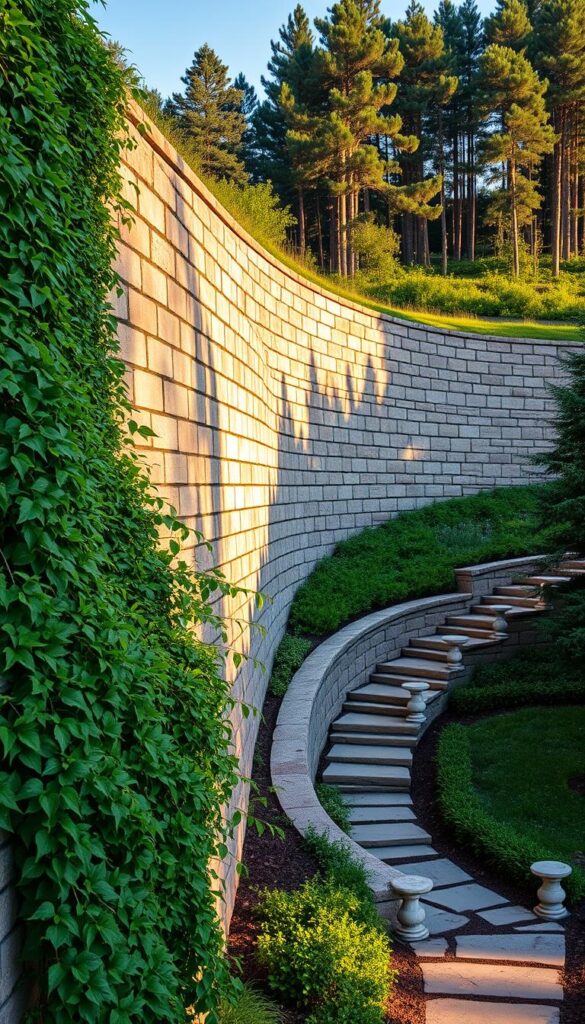
Stone and Concrete Block Retaining Systems
Stone and concrete block walls are durable and versatile. They can handle a lot of soil pressure. You can choose from many styles, like concrete blocks for a modern look or natural stone for a rustic feel.
Timber and Wood Retaining Structures for Natural Aesthetics
Timber walls add a natural, warm look to outdoor spaces. Treated wood can last long, fighting off rot and bugs. But, think about the environmental impact and upkeep of timber walls.
“A well-maintained timber retaining wall can be a beautiful and functional addition to any hillside property.”
Innovative Gabion and Alternative Retaining Wall Designs
Gabion walls use wire baskets filled with stones for a unique, eco-friendly option. They let water drain naturally and match many landscape styles. Other options include using recycled materials or living walls with plants. These designs not only stabilize hills but also make your landscape more interesting.
Choosing the right retaining wall can make your steep hill safe and beautiful. It enhances your outdoor space.
Optimal Plant Selection for Steep Hill Landscaping
Choosing the right plants is key for a beautiful and stable outdoor space on steep hills. The right plants stop soil erosion, cut down on upkeep, and make your property look better.
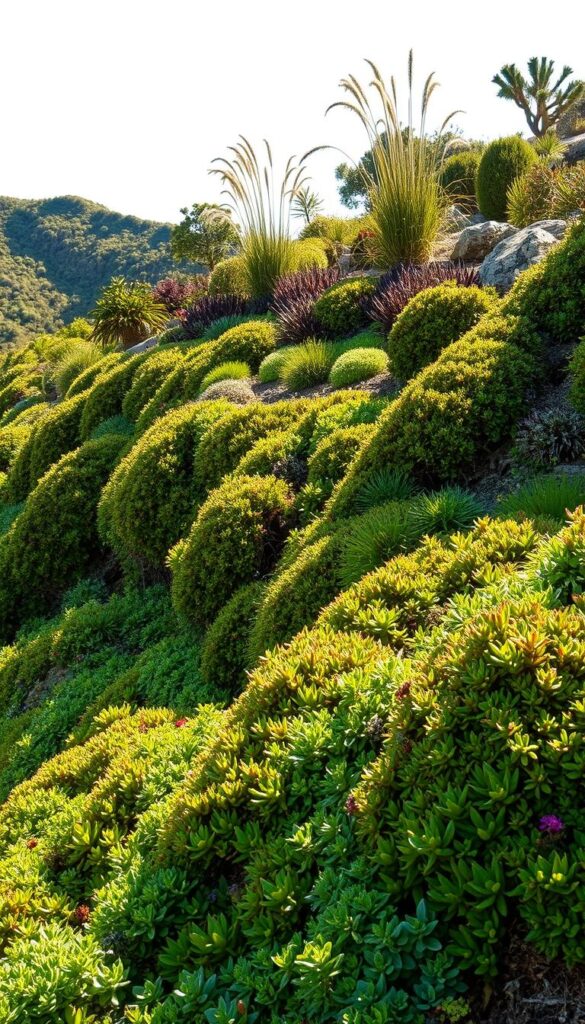
Deep-Rooted Ground Covers for Soil Stabilization
Deep-rooted ground covers are great for keeping soil stable on steep hills. Plants like Phlox subulata (creeping phlox) and Vinca minor (periwinkle) have strong roots that keep the soil in place. They’re also easy to care for and can grow well in many conditions.
Strategic Placement of Shrubs and Trees on Slopes
Shrubs and trees are vital for adding stability and beauty to steep hills. Pick plants that grow big and have deep roots. For example, junipers and cedars are good for slopes because they have deep roots and can handle tough conditions. Placing these plants smartly can stop soil from running off and make your landscape more stable.
“The right plants can transform a challenging slope into a beautiful and functional part of your landscape.” – Landscape Design Expert
Ornamental Grasses and Perennials for Hillside Beauty
Ornamental grasses and perennials bring beauty and texture to hillside landscapes. Plants like Miscanthus sinensis (silver grass) and Liatris (blazing star) look great and help keep the soil stable. They’re easy to care for and can handle different soils, making them perfect for steep hills.
By picking and placing the right plants, you can make your steep hill look amazing and stable. Think about the soil, weather, and upkeep needs when picking plants. This will help your landscaping project succeed in the long run.
Budget-Friendly Walkway Ideas You Can DIY on Slopes
Creating a walkway on a slope doesn’t have to be expensive. Here are some DIY ideas to consider. Landscaping on a slope can be challenging, but with creativity and affordable materials, you can make a beautiful walkway.
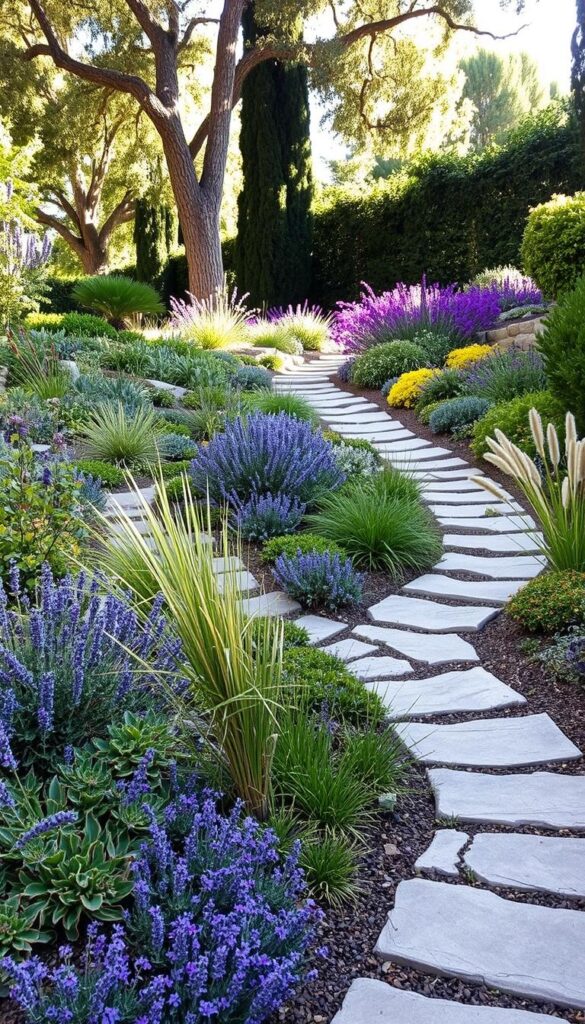
Affordable Stepping Stone Path Designs
Stepping stone paths are perfect for slopes because they drain well and fit the terrain. Use flat stones or concrete pavers for a path that adds interest. To save money, use stones or pavers you already have or find them at a local salvage yard.
- Choose stones or pavers that are flat and stable
- Use a level to ensure the stones are properly aligned
- Consider adding plants or moss between the stones for a more natural look
Low-Cost Gravel and Mulch Pathway Solutions
Gravel and mulch pathways are cheap and easy to install. They blend well with the landscape. Gravel pathways drain water, preventing erosion. Mulch pathways suppress weeds and add a rustic look.
Tips for installing gravel or mulch pathways:
- Clear the area of any debris or weeds
- Lay down a layer of landscape fabric to prevent weeds
- Spread the gravel or mulch evenly, maintaining a consistent depth
Repurposed Material Walkways for Eco-Friendly Landscapes
Using repurposed materials for your walkway is budget-friendly and eco-friendly. Old bricks, wooden planks, or recycled materials can create a unique pathway. This approach adds character and reduces waste.
Simple Walkway Upgrades on a Budget
To enhance your walkway without spending a lot, try simple upgrades. Add lighting, decorative edging, or plants. Solar-powered lights are affordable and eco-friendly. Decorative edging can be made from various materials, finishing your walkway nicely.
These budget-friendly ideas can improve your slope’s beauty and function without overspending. Whether you choose stepping stones, gravel, mulch, or repurposed materials, your DIY project will show your creativity.
Designing Safe and Attractive Stairs for Hillside Access
Safe and attractive stairs are key for hillside properties. There are many design options to think about. It’s important to mix beauty with safety.
The material of your stairs affects both safety and looks. Let’s look at some common choices.
Natural Stone Step Installations and Patterns
Natural stone steps are loved for their strength and beauty. They come in different patterns, like running bond or stacked. Natural stone is also good for preventing slips, making it safe.
Wooden and Composite Stairway Options for Slopes
Wooden and composite stairs add a cozy feel to any landscape. They’re easy to design with, but need regular care to stay safe and strong.
Essential Safety Features for Hillside Steps and Stairs
Adding safety features to your stairs is crucial, no matter the material. Make sure steps are the right height and depth. Install handrails and use non-slip surfaces.

| Material | Safety Features | Aesthetic Appeal |
|---|---|---|
| Natural Stone | Slip-resistant, durable | Natural beauty, various patterns |
| Wooden/Composite | Can be made slip-resistant, requires maintenance | Warm, inviting look, flexible design |
Think about both looks and safety when designing stairs. This way, your hillside access will be both useful and lovely.
Incorporating Water Features in Steep Hill Landscaping
Water features can turn your hillside into a peaceful and beautiful place. Adding cascading waterfalls and rain gardens can make your property more stunning. They also help with the challenges of steep slopes.
Designing Cascading Waterfalls and Stream Features
Cascading waterfalls and streams bring life and calm to your hillside. When planning these, think about the slope’s angle and soil type. This ensures they stay stable and don’t cause erosion. Using rocks and boulders can make the waterfall look natural.
| Feature | Benefits | Considerations |
|---|---|---|
| Cascading Waterfalls | Aesthetic appeal, soothing sounds | Slope stability, water source |
| Stream Features | Dynamic movement, habitat creation | Erosion control, maintenance access |
Functional Rain Gardens and Bioswales for Sloped Properties
Rain gardens and bioswales are not just pretty. They also help manage rainwater and prevent erosion. By placing them wisely, you can make your landscape more sustainable and strong, even on tough slopes.

Adding water features like cascading waterfalls and rain gardens to your steep hill landscaping makes a unique and beautiful outdoor space. It boosts your property’s beauty and value.
Strategic Lighting to Enhance Your Hillside Landscape
A well-designed lighting plan can make your hillside landscape look better and work better. It highlights your outdoor space’s best features. It also makes sure it’s safe and easy to move around, especially on slopes and stairs.
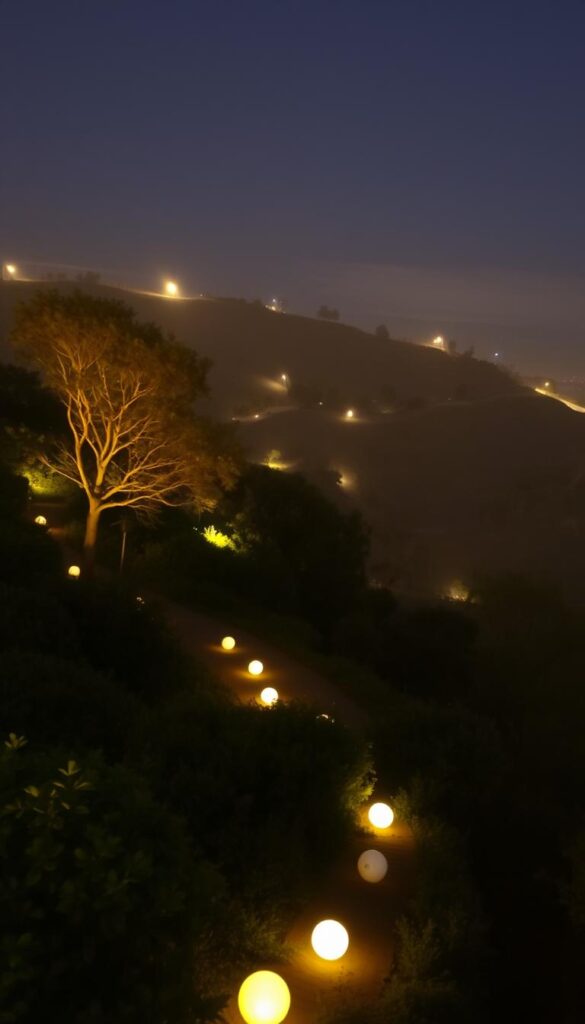
Path and Stair Lighting for Safety and Navigation
Good lighting on paths and stairs is key to avoiding accidents on your hillside. It lights up walkways and stairs, cutting down on slips, trips, and falls. Use low-voltage LED lights or solar-powered ones for energy savings and easy setup.
Some top path lighting methods include:
- Step lights: Embedded into stairs to provide direct illumination
- Pathway lights: Low-profile fixtures that line walkways
- Deck lights: Installed under railings or on deck surfaces
Accent Lighting Techniques to Highlight Landscape Features
Accent lighting can really make your hillside landscape pop. By placing lights smartly, you can show off special trees, water features, or buildings. Use uplighting, downlighting, and silhouetting to add depth and drama.
| Lighting Technique | Description | Effect |
|---|---|---|
| Uplighting | Placing lights at ground level to shine upwards | Highlights trees, architectural features |
| Downlighting | Positioning lights above to shine downwards | Mimics natural moonlight, creates ambiance |
| Silhouetting | Backlighting objects against a brighter background | Creates dramatic silhouettes |
By using these smart lighting strategies, you can turn your hillside landscape into a beautiful and safe spot. It’s perfect for enjoying day or night.
Low-Maintenance Approaches to Steep Hill Landscapes
You can have a beautiful steep hill landscape without constant upkeep. The right strategies can turn your challenging slope into a stunning outdoor space. This space will need less care.

Xeriscaping Strategies for Reduced Hillside Maintenance
Xeriscaping is great for keeping steep hillsides low maintenance. It uses drought-tolerant plants and efficient irrigation. This cuts down on water use and upkeep.
Choosing plants native to your area or ones that like dry conditions helps a lot. You’ll need to water and prune less often.
“Xeriscaping can cut water use by up to 50%,” which is good for your wallet and the planet. Mulch and gravel also help keep moisture in, fight weeds, and stop erosion.
Automated Irrigation Solutions for Difficult-to-Access Slopes
Automated irrigation systems are a big help for steep hill landscapes. They water plants at the best times, saving water. Modern systems adjust based on weather, soil, and plant needs, making them very efficient.
Smart technology in your irrigation lets you control watering from anywhere. This saves time and prevents overwatering. Overwatering can cause erosion and other problems on steep slopes.
Seasonal Care and Maintenance for Hillside Gardens
The seasons change, and so does the care needed for your hillside garden. Different weather brings different challenges. You need to adapt your care to keep your garden looking great.
Protecting Your Hillside in Winter
Winter can be tough on hillside gardens. Cold, snow, and ice can cause damage. To keep your garden safe:
- Apply a layer of mulch to keep roots warm and prevent erosion.
- Use burlap or snow fencing to shield plants from wind and snow.
- Make sure water drains well to avoid ice and waterlogging.
Winter protection is key to keeping your garden intact.
Spring and Summer Maintenance for Healthy Hillsides
When it gets warmer, your garden needs attention to stay healthy. Important tasks include:
- Check and fix any damage to walls or terracing.
- Prune plants to keep them looking good and growing well.
- Water plants right to avoid erosion and keep them happy.
Regular maintenance in spring and summer keeps your garden beautiful and useful.

Inexpensive Pathway Projects: When to DIY vs. Hire Professionals
Homeowners often wonder if they should do it themselves or hire pros for pathways on steep hillsides. The decision depends on the project’s complexity, your budget, and your skills.
Hillside Projects Suitable for Homeowner Implementation
For simple projects like stepping stones or gravel, DIY is usually okay. These tasks need little digging and basic tools. Key DIY considerations include:
- Checking the slope’s grade for stability
- Picking the right materials for your climate and soil
- Ensuring proper drainage to avoid erosion
| Project Type | DIY Suitability | Professional Recommendation |
|---|---|---|
| Simple Stepping Stone Path | Yes | No |
| Complex Terraced Pathway | No | Yes |
| Gravel or Mulch Pathway | Yes | No |
When Professional Expertise Is Worth the Investment
For complex projects needing lots of digging or structural work like retaining walls, pros are best. Experts have the experience to assess the land, design, and execute safely and well.
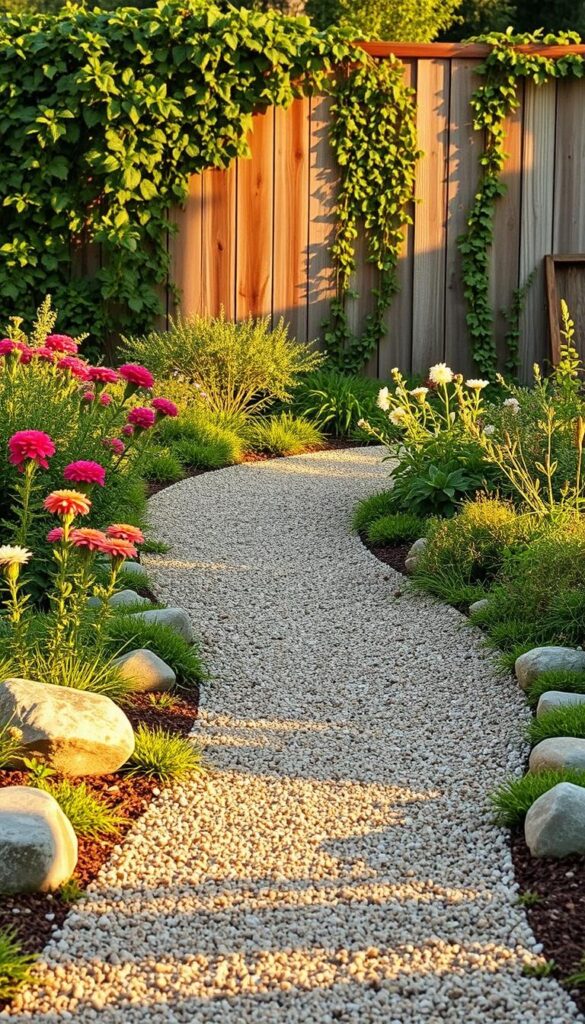
Knowing your project’s scope and your skills helps decide between DIY or hiring pros for your pathway.
Transformative Steep Hill Landscaping Success Stories
Steep hill landscaping can seem tough, but many homeowners have made their slopes beautiful. These changes not only make the property look better but also add value and function.
Before and After Case Studies from Various Regions
Homeowners in different places have found creative ways to landscape their steep hills. For example, a California homeowner turned a bare slope into a colorful, terraced garden. The garden has a winding stone path and lots of flowers.

In Colorado, a steep hill was turned into a cozy outdoor area. It has tiered seating and a fire pit. These stories show how steep hills can become beautiful and useful spaces.
Design Inspiration for Different Property Types and Climates
Every property, whether by the coast or in the mountains, can be beautifully landscaped. Coastal homes look great with drought-resistant plants and natural stone. Mountain homes do well with native plants and wooden structures that fit in with nature.
“The key to a successful steep hill landscaping project lies in understanding the unique conditions of your property and selecting design elements that complement those conditions.” By learning from others and tailoring designs to your place, you can create a stunning landscape.
Conclusion: Embracing Your Hillside’s Unique Potential
Exploring steep hill landscaping shows that transforming your outdoor space needs careful planning and creativity. It also requires embracing the unique challenges and opportunities of your hillside property.
By following the principles in this article, you can unlock your hillside’s full potential. This will create a beautiful, functional, and safe outdoor space. It will also enhance your home’s value and improve your quality of life.
Looking to prevent erosion, create functional spaces, or boost your property’s look? The right landscaping strategies can help a lot. Remember to think about drainage, plant selection, and maintenance when starting your project. This will help ensure a successful outcome.
By doing this, you’ll not only make your property more beautiful and functional. You’ll also realize your hillside’s full potential. This will create a unique and enjoyable outdoor space that shows off your personal style and complements your home.